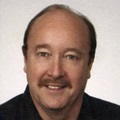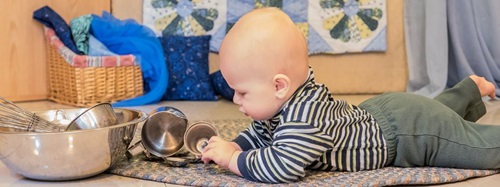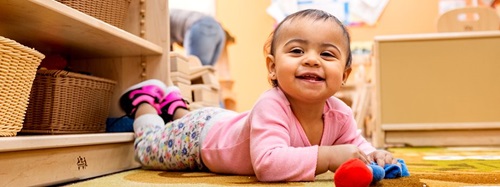Great Places to be a Baby
Infants and Toddlers' Learning Environments
| July 2005The baby's first place is a person. When young infants enter child care, they have come from a place of flesh and fluid; first inside that place, and subsequently, almost always attached to adjacent to that place — mother. Physical and emotional contact between the baby and the mother/place is the territory of the infant's development. Babies enter the world with four big jobs:
- To make sense of the world. Through exploring the sensoryscape of the places they enter, infants progress from seeing to looking, smelling to sniffing, hearing to listening, feeling to touching, and from being moved about to moving.
- Discover and develop all their bodily powers. The landscapes they inhabit help or inhibit their efforts to move from laying around to roll over to pull up, from creeping to crawling to stepping to toddling, from grasping to holding to dropping to tossing, from finding to searching, from poking to digging, from doing to thinking and planning.
- To fully connect with others. Through coming to deeply know others and be known and prized, babies move from the womb to the world, from mothers to others, to "I" to "we" to "us," from instinct to basic trust, from total dependancy to autonomy, from only I want to I want to give.
- To learn to communicate fully: Through conversation, babies go from cries and gurgles to many vocalizations; from : Ma or Da to hundreds of words; from: "I want" to "please pass the potatoes"; from talk to drawing to writing.
What do they do?
If those are the important jobs of infants and toddlers, what do they actually do? Infants and toddlers are extraordinarily competent sensory motor scientists who systematically investigate their world using their scientific tools: mouth, eyes, skin, ears, and their developing muscles. Toddlers are babies determined to get into things, use their new mobility to explore with their whole bodies, their mouths, their skin, all their senses and soon their newly competent hands, fingers and feet.
Some of the main things a young baby does: see; watch; look; inspect; hear; listen; smell; taste; feel; touch; mouth; eat; reach out; reach for; knock away; grasp; hold; squeeze; pinch; drop; transfer hand to hand; shake; bang; tear; clap together; put in; take out; find; look for; kick; turn; roll; lift their heads up; sit up; pull up; crawl to, in, out, over; creep around, in, and under; swing; rock; coo; babble; imitate sounds; react to others; accommodate to others; solicit from others; and experiment endlessly.
In addition to doing many of the above, older babies: walk in, out, up down, over, under, around, though; climb in, up, over, on top; slide; swing; hang; jump; tumble; take apart; put together; stack; pile; nest; set up; knock over; collect; gather; fill; dump; inspect; examine; select; sort; match ; order; carry; transport; rearrange; put in; take out; hide; discover; investigate by trial and error; explore with each sense; imitate familiar acts; try adult behavior; doll play; paint; smear; draw; mix; separate; pour; sift; splash; make sounds and words; label; "read" symbols; converse; follow directions; cuddle; hug; kiss; test others; accommodate to others; and help themselves wash, eat, dress.
A word about toddlers and young twos: Neither infants nor preschoolers, toddlers and young twos are furiously becoming: increasingly mobile, autonomous, social creatures armed with new language and insatiable urges to test and experiment. They embody contradtions: anarchists with an instinct to herd and cluster, assertive and independent now, passive and completely dependent moments later. These restless mobile characters have a drive to take apart the existing order and rearrange it, by force if necessary, to suit their own whimsically logical view of the universe. (The label terrible twos speaks to the lack of appreciation for the toddler mode of being.)







